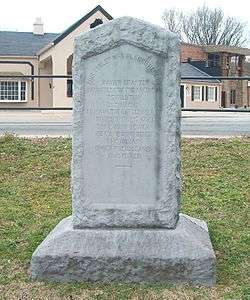Battle of Hightower
| Battle of Hightower | |||||||
|---|---|---|---|---|---|---|---|
| Part of Cherokee–American wars | |||||||
| |||||||
| Belligerents | |||||||
| Cherokee | Tennessee Militia | ||||||
| Commanders and leaders | |||||||
| Kingfisher |
General John Sevier Colonel John Blair Colonel Christian Colonel Kelly Captain Evans | ||||||
| Strength | |||||||
| Several hundred Cherokee | 800 mounted Tennessee volunteers | ||||||
| Casualties and losses | |||||||
| At least 3 killed and many wounded | 3 killed, 3 wounded | ||||||
The Battle of Hightower (also called Battle of Etowah) in 1793 was part of the Cherokee–American wars, in which the Cherokee sought to defend their territory from illegal immigration by white settlers. This particular battle took place at the Cherokee village of Etowah Town (Itawayi), overlooking Downtown Rome, GA in the modern Floyd County, Georgia, resulting in the defeat of the Cherokee by a force led by John Sevier, future Governor of Tennessee.
Prelude
In the 1785 Treaty of Hopewell, the Cherokee agreed to come under the sovereignty of the new United States and the treaty specified boundaries of a huge area of Tennessee, Eastern North Carolina and South Carolina, and Northern Georgia to be reserved as Cherokee hunting grounds. Article 5 stated that any non-Indians settling in this area would lose the protection of the United States and that the Cherokee could punish them any way they pleased.[1]
New settlers continued to move into the Cherokee area, however, and attacks by the Cherokee to drive them out and counter-attacks by the settlers became widespread and vicious. Technically, the United States violated the 1785 Treaty of Hopewell by failing to enforce Article 7, which required the United States to enforce justice on U.S. citizens who murdered Cherokee, and the Cherokee violated the treaty by failing to adhere to Article 9 by trading directly with Spain. Arguments could be made that both sides violated Article 8 regarding retaliation.
Trigging Event
With the approval of President George Washington, an attempt was made to negotiate a new treaty in the Southwest Territory (now the State of Tennessee), but the meeting place was raided by a party headed by John Sevier. Sevier ordered Captain John Beard to attack, and many Cherokee were killed. Washington ordered the arrest and trial of Beard, but Sevier helped him escape and avoid trial.
In retaliation, arguably justified under the "manifest violation" clause of Article 8, John Watts led a war party of over 1,000 Chickamauga Cherokee and Muscogee Creek in a series of attacks against unauthorized settlements on Cherokee land in preparation to attack Knoxville, Tennessee. Near Knoxville Road on the French Broad River, the Cherokee attacked the Cavett's Station settlement with several killed on both sides. The surviving settlers surrendered when Watts offered clemency, but a faction of Cherokee under Doublehead opposed the clemency and starting killing the prisoners, including children. James Vann was on Watts' side trying to protect the prisoners from Doublehead's men.
Battle of Hightower

Word of the massacre spread quickly and John Sevier raised a force to combat the Cherokee. The Cherokee force split up with some heading toward Kentucky and some toward North Carolina, but most headed toward Georgia. Sevier's men caught the Cherokee at the village of what he called Hightower (Etowah, or Itawayi), which is near the present-day site of Rome, Georgia. The Cherokee created a defensive position on Myrtle Hill[2] and used a guard to try to prevent Sevier from fording the rivers.
Sevier left a written account of the battle,[3] in which he described an attempt to cross the Etowah River about a mile south of Myrtle Hill, drawing the Cherokee defenders out of their prepared positions, then galloping back to Myrtle Hill to cross there. The Cherokee rushed back to contest the crossing of the Etowah, but failed. When Kingfisher was killed, the remaining warriors fled, and Sevier burned the village.
Aftermath
Now unopposed, Sevier's force moved west down the Coosa River destroying Cherokee and Creek villages before returning to the Knoxville area. The "Battle of Hightower" was Sevier's last of many battles against Native Americans and came to be known as his Etowah campaign. It was the last pitched battle between the Lower Cherokee under John Watts and American forces until the Nickajack Expedition in September 1794.
Myrtle Hill is now a cemetery, and there is a stone on the hill memorializing this battle.[4]
Notes
- ↑ 1785 Treaty of Hopewell
- ↑ Desmond, Jerry, Georgia's Rome: A Brief History ISBN 1-59629-309-8 (1998), The History Press, pp. 21–23
- ↑ Heiskell, Samual Gordon, Andrew Jackson and Early Tennessee History, Tennessee: Ambrose Printing Co., Volume 1, Second Edition, 1920, Chapter 19, pages 328–330
- ↑ North Georgia The Battle of Hightower Article